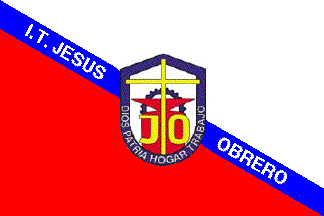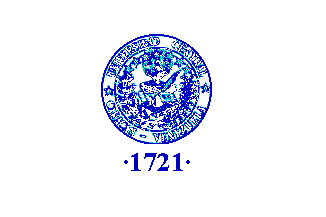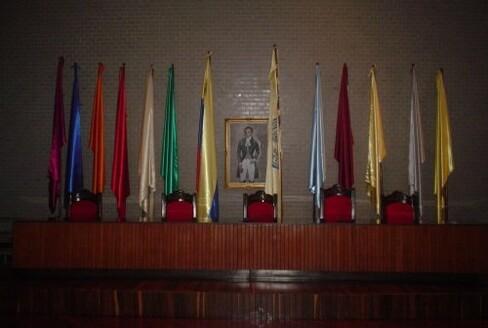
image by Ivan Sache, 8 November 2010

Last modified: 2025-01-11 by daniel rentería
Keywords: venezuela | university |
Links: FOTW homepage |
search |
disclaimer and copyright |
write us |
mirrors
See also:
Other Sites:

image by Ivan Sache, 8 November 2010
Colegio Alemán de Maracaibo started in 1926 as Colegio Alemán (German School),
the first foreign - but not restricted to the German community - school in
Maracaibo. Closed in 1942, the institute was reinstated in 1952 as Colegio
Alemán del Zulia, eventually renamed on 7 January 1967 Colegio Alemán de
Maracaibo. The institute is managed by the non-profit association Deutscher
Schulverein Maracaibo (Maracaibo German School Association).
The flag of Colegio Alemán de Maracaibo, as shown graphically on the
institute's website, is white
with the coat of arms of the institute in the middle.
The coat of arms of Colegio Alemán de Maracaibo is "Quarterly, 1. A Venezuelan
flag, 2. Vert an open book argent, 3. Azure an owl argent, 4. A German flag."
The name of the institute is written in black letters above the shield. The
Venezuelan flag is shown here with seven stars, while having been added another
star in 2006; whether the institute's coat of arms and flag was updated
accordingly, or not, is unknown to me.
Source:
http://www.cam.edu.ve/simbolos.htm
Ivan Sache, 8 November 2010

image by Ivan Sache, 03 July 2014
Colegio Eugenia Ravasco was established in 1978 in Los Chorros borough
(Caracas) by the Congregation of the Daughters of the Holy Hearts of Jesus and
Mary. Founded in 1868 by the Italian nun Eugenia Ravasco (1845-1900; beatified
on 27 April 2003 by Pope John Paul II), the congregation settled in Venezuela in
1951, where they are best known as the Ravasco Sisters.
The flag of the institute is yellow with the emblem of the congregation in the
middle, formed of two adjacent shields:
- left, a yellow shield charged with the two red Sacred Hearts of Jesus and
Mary;
- right, a blue shield with a yellow leopard and two yellow bends, symbolizing
the power of the Ravasco family.
Source:
http://www.colegioeugeniaravasco.edu.ve/bandera_colegio.asp - Institute's
website
Ivan Sache, 03 July 2014

image by Ivan Sache, 13 July 2014
Colegio San Gabriel Archangel was established in 1977 in Valencia (Carabobo
State) by Ana María Torreiro de Pérez and Esteban Pérez Poza. Originally named
Jardín de Infancia El Niño Jesus and located in the Camoruco borough, the
institute was renamed Complejo Educativo Colegio San Gabriel Archangel in 1982,
when transferred to the Valles de Camoruco borough. The institute is named for
Archangel Gabriel, the name being also a tribute to Gabriel Pan, benefactor and
instigator of the institute.
The symbols of the institute were designed by its founders, Ana María Torreiro
de Pérez and Esteban Pérez Poza.
The flag is horizontally divided blue-yellow with the institute's emblem placed
near the hoist. Blue is a symbol of highness and an invitation to love God and
the neighbour. Blue is a also a symbol of thought, dedication and
conscience. Yellow is a symbol of spiritual wealth and of light.
The emblem features:
- two wings, representing Archangel Gabriel, the protector of the
institute and of its community;
- light rays, which provide guidance;
- a book, representing science, knowledge, investigation, and discovery, charged
with the institute's motto, "MORAL Y LUCES" [Moral and Enlightenment];
- a yellow scroll inscribed with the institute's name in red letters.
Source:
http://www.sangabrielarcangel.org/index.php/features/menu-options -
Institute website
Ivan Sache, 13 July 2014

image by Ivan Sache, 13 July 2014
Instituto Técnico Jesús Obrero (ITJO) was established in 1948 by the Society
of Jesus in the Catia borough (Caracas), where the Jesuits had erected a chapel
in 1941; in 1948, Father Dionisio Goicoechea established Escuela Virgen de los
Dolores, subsequently transformed into a technical school aimed at teaching
technical jobs to worker's ["obreros"] children.
The flag of the institute is diagonally divided white-red by a blue bend charged
with "I.T. JESUS / OBRERO" in white letters. In the middle is placed the
institute's emblem.
The emblem of the institute is a white shield with a blue border charged with
the institute's motto "DIOS PATRIA HOGAR TRABAJO" [God Homeland Home Work] in
white letters. The shield is charged with a red anvil superimposed to a blue
cogwheel and superimposed by a yellow Christian cross surrounded by the yellow
letters "JO". The shield is surrounded by green branches, omitted on the flag.
Source:
http://www.cerpe.org.ve/instituto-tecnico-jesus-obrero-catia.html -
Institute's webpage
Ivan Sache, 13 July 2014
The flag and coat of arms of the education institue Liceo
Bolivariano "Hilario Pizani Anselmi", located in
Motatán, shall be selected on 12 May 2006. The selection process
started on 11 May 2006 with the presentation of 38 flags and 38
coat of arms, one by section of the institute. For the second
round, 12 flags and 12 coats of arms have been kept.
Source: <www.diarioeltiempo.com.ve>.
Ivan Sache, 13 May 2006
On July 18, 2010 I found the flag of the UBV (Universidad Bolivariana de
Venezuala):
- image:
http://www.ubv.edu.ve/images/stories/simbolos/Bandera.gif (website:
http://www.ubv.edu.ve/index.php?option=com_content&view=article&id=86&Itemid=45)
It is the first public University established in the last decade in Venezuela,
in 2003.
Source:
http://es.wikipedia.org/wiki/Universidad_bolivariana_de_venezuela
Esteban Rivera, 15 August 2010

image by Guillermo T. Aveledo , 21 December 1999
Flag bearing year of foundation

image by Guillermo T. Aveledo , 21 December 1999
Flag bearing year of start of classes
Universidad Central de Venezuela (Central University of
Venezuela; founded 1721).
Description: A white field (although sometimes light yellow or
even beige are used; there are no official specifications to this
flag besides the ones I'm giving) with the Seal of the University
and the date "1721" (date it was founded) on royal blue
(embroidered under the seal on roman type letters). The seal
consists of a few Academic and National symbols: Encircled by the
words "*Universidad Central* Caracas-Venezuela", we see
seven stars (as the ones in the national flag) over a shining oil
lamp (which symbolises enlightment and sums up the University's
motto: "the house that overcomes the shadows") which
sits on two books (philosophy and science), old papers and an
inkpot with a pen on a book (history). Branches of Coffee and Palm
encircle the lower part of the arrangement (as a connection to
the tropical reality the University stands in).
Guillermo T. Aveledo, 21 December 1999
The official website of UCV presents the flags of the Faculties as
"rectangular flags with the Faculty emblem in the middle (non official), or,
with the UCV emblem in upper hoist (official)". The colors of the flags are
given as follows:
- Agronomy: Green
- Architecture and Urbanism: Sky blue
- Sciences: Beige
- Economic and Social Sciences: Wine red
- Law and Political Sciences: Blood red
- Veterinary Sciences: Light yellow
- Pharmacy: Orange
- Humanities and Education: Gray
- Engineering: Electric blue
- Medicine: Yellow
- Odontology: Purple.
This is, with shade variations, the same (national?) color scheme as used by the
Faculties of "Universitad del Zulia". There is a
photo of the flag row
Ivan Sache, 30 July 2011
"Universidad Central de Venezuela, UCV" [Central University
of Venezuela] was established on December 22, 1721.
Sources: [1] and
[2].
La bandera de la UCV consiste en una tela rectangular de color beige
con el emblema ubicado en el centro. Suele ubicarse al lado derecho de
la bandera nacional y al izquierdo de las de las facultades.
(in English: The UCV flag consists of a beige rectangular fabric with the
emblem located in the center. It is usually located on the right side
of the national flag and on the left of those of the faculties)
Source: [3].
Esteban Rivera, 4 January 2025

image by Guillermo T. Aveledo, 15 September 2000
Bomberos Universitarios - Universidad Central de Venezuela
(University Fire Brigade - Central University of Venezuela)
Guillermo T. Aveledo, 15 September 2000

image by Guillermo T. Aveledo, 15 September 2000
As already mentioned by Ivan Saché then, the eleven Faculty flags back
in 2011, the Faculties' flags (background colors) are as follows:
-Facultad de Agronomía [Faculty of Agronomy; official website: http://www.ucv.ve/agronom%C3%ADa]:
Green (same as this background)
-Facultad de Arquitectura y Urbanismo [Faculty of Architecture and Urban Planning; official website: http://www.ucv.ve/fau]:
Sky blue
-Facultad de Ciencias [Faculty of Sciences; official website: http://www.ucv.ve/ciencias]:
Beige (same as this background)
-Facultad de Ciencias Económicas y Sociales [Faculty of Economic and Social Sciences; official website: http://www.ucv.ve/faces]:
Wine red (same as this background)
-Facultad de Ciencias Jurídicas y Políticas [Faculty of Legal and Political Sciences; official website: http://www.ucv.ve/cienciasjuridicas]:
Blood red (same as this background: this background]
-Facultad de Ciencias Veterinarias [Faculty of Veterinary Sciences; official website: http://www.ucv.ve/veterinaria]:
Light yellow (same as this background]
Facultad de Farmacia [Faculty of Pharmacy; official website: http://www.ucv.ve/farmacia]:
Orange
-Facultad de Humanidades y Educación [Faculty of Humanities and Education]
Grey (same as this background)
-Facultad de Ingeniería [Faculty of Engineering; official website: http://www.ucv.ve/ingenieria]
Electric blue (same as this background)
-Facultad de Medicina [Faculty of Medicine]:
Yellow (same as this background]
-Facultad de Odontología [Faculty of Dentistry; official website: http://www.ucv.ve/odontologia]
Purple (same as this background)
Esteban Rivera, 4 January 2025
.gif)
image from Wikimedia Commons

image by Blas Delgado Ortiz, 20 April 2002
Néstor Garrido of Venezimbol presented the flag of the
Catholic University Andrés Bello (Universidad Católica Andrés
Bello). Its dimensions are not regulated. Its symbology is as
follows:
The flag is a horizontal triband of equal dimensions: blue, white
and yellow in descending order. Blue and white are the colors of
the Virgin Mary, and at the same time, white and yellow are the
Vatican’s colors, that certifies the Catholic and Marian
character of this University. The shade of blue is a dark sky
blue.
Blas Delgado Ortiz, 20 April 2002
Universidad Católica Andrés Bello (UCAB), founded in October
1953, has three campuses in Caracas (main seat), Guayana and
Coro. It is a private University granted in 1951 by the
Venezuelan Episcopacy to the Society of Jesus.
The University is named after the humanist, poet, philologist and
lawmaker Andrés de Jesús María y José Bello López
(1781-1865).
The flag appears to be also used as the chief of the shield of
the University.
Source: <www.ucab.edu.ve>.
Ivan Sache, 4 March 2007

image by Ivan Sache, 6 March 2007
Historic outline: The first university in Carabobo
was created in Valencia in 1833 by a
Decree of President of the Republic, General José A. Paez, as
Colegio de Carabobo. The college was renamed Colegio Nacional de
Carabobo in 1870 by Special Decree of the President, General
Antonio Guzmán Blanco. However, the College was closed in 3
October 1874 following economical and political difficulties.
In 1880, Engineer Lino Revenga started the building of the seat
of a new university (today the Faculty of Law); on 15 November
1892, a Decree by the President, General Joaquín Crespo, created
the Ilustre Universidad de Valencia. General Cipriano Castro
closed the University by Decree on 1904. On 12 March 1915, the
Constutional President of the State of Carabobo, Emilio
Fernández, founded by Decree the Instituto Oficial de Ciencias
Políticas, named Miguel José Sanz after the founder of the
first Law College in Venezuela. On 13 December 1949, the
Institute was incorporated into the Law Faculty of the Universidad Central de Venezuela.
On 21 March 1958, Decree No 100 of the Governing Junta, presided
by Rear Admiral Wolfgang Larrazabal, (re)founded the Universidad
de Carabobo.
Symbols: The flag of Universidad de Carabobo is made of three
equal horizontal stripes, gold (symbolizing faith), green
(symbolizing liberty), and purple (symbolizing culture). These
colours are the official colours of the University; they are also
used in the three quarters of the shield of the University, which
is placed in the canton of the flag. The shield is rectangular,
in "Spanish" style with a point in base. It is made of
two upper quarters of equal size and one bigger lower quarter.
The upper left quarter depicts the Annunciation, on a golden
background representing faith. The upper right quarter represents
the column prescribed by the Cúcuta Congress to commemorate the
Battle of Carabobo. On the column is the writing "24 de
junio de 1821" (24 June 1821). The background of the column
is a sun with yellow rays in a blue sky and a green pampa. The
two upper quarters are separated from the lower quarter by a
black stripe bearing two years in Roman numerlas, MDCCCXCII
(1892, year of creation of the University by Joaquín Crespo) and
MCMLVIII (1958, year of refoundation of the University). The
lower quarter shows the facade of the former University of
Valencia, today the Faculty of Law of the University of Carabobo,
designed by Lino J. Revenga; the building is surmonted by a
purple sky. The chief of the shield bears the
motto "Deus, Libertas, Cultura" (God,
Liberty, Culture), written in white Capital letters on a blacjk
background; the lower border of the shield bears the writing
"Universitas Carabobensis", the name of the University
in Latin.
Source: <www.uc.edu.ve>.
Legislation: Chapter III of the regulation on the symbols of the
University says the colour are 'Oro, Verde y Purpura',
symbolizing faith, liberty, and culture, respectively (Article
5). The flag shall be hoisted on all buidings belonging to the
University (Faculties, Schools, Institutes, and Centers) on
Memorial Day of the reopening of the University and ceremony days
dedicated to professors, students, employees and other members of
the University (Article 7). The use of the flag in other
instances is subjected to the authorization by the Rector of the
University (Article 8).
Source: <www.rectorado.uc.edu.ve>.
Ivan Sache, 6 March 2007




